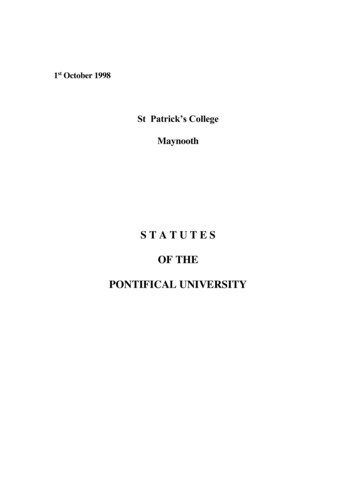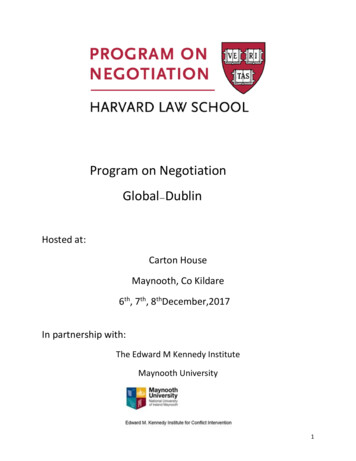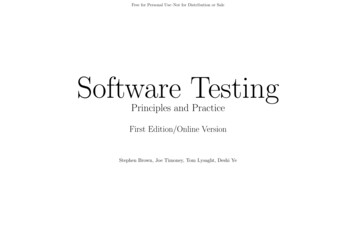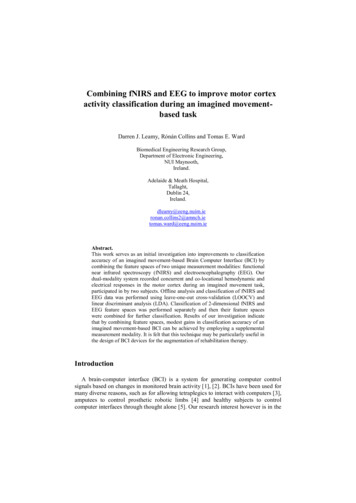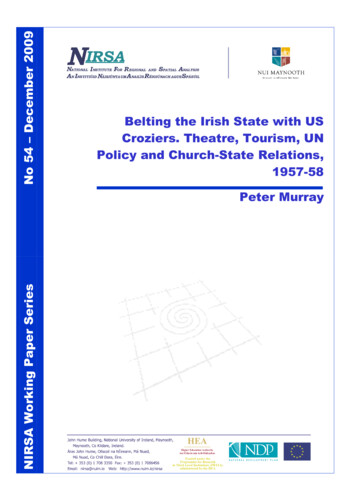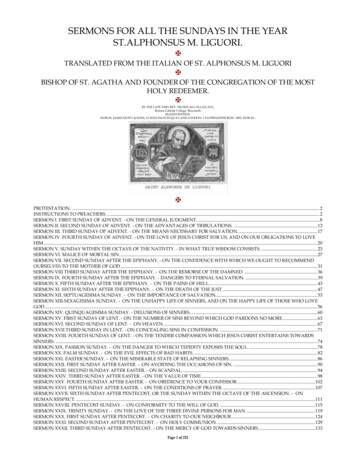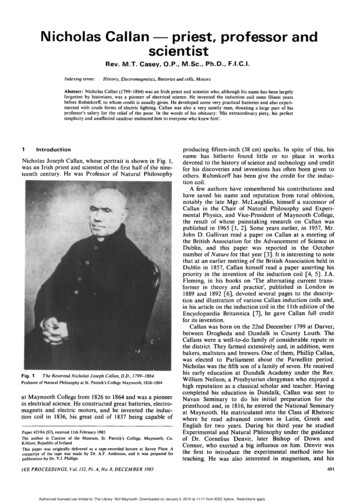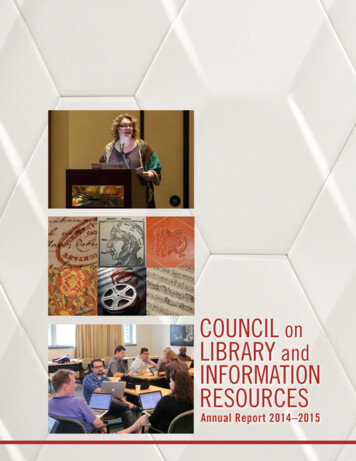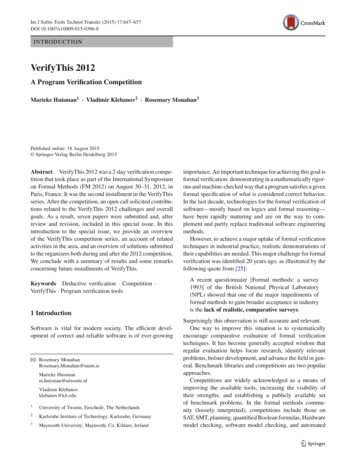
Transcription
Int J Softw Tools Technol Transfer (2015) 17:647–657DOI 10.1007/s10009-015-0396-8INTRODUCTIONVerifyThis 2012A Program Verification CompetitionMarieke Huisman1 · Vladimir Klebanov2 · Rosemary Monahan3Published online: 18 August 2015 Springer-Verlag Berlin Heidelberg 2015Abstract VerifyThis 2012 was a 2-day verification competition that took place as part of the International Symposiumon Formal Methods (FM 2012) on August 30–31, 2012, inParis, France. It was the second installment in the VerifyThisseries. After the competition, an open call solicited contributions related to the VerifyThis 2012 challenges and overallgoals. As a result, seven papers were submitted and, afterreview and revision, included in this special issue. In thisintroduction to the special issue, we provide an overviewof the VerifyThis competition series, an account of relatedactivities in the area, and an overview of solutions submittedto the organizers both during and after the 2012 competition.We conclude with a summary of results and some remarksconcerning future installments of VerifyThis.Keywords Deductive verification · Competition ·VerifyThis · Program verification tools1 IntroductionSoftware is vital for modern society. The efficient development of correct and reliable software is of ever-growingBRosemary MonahanRosemary.Monahan@nuim.ieMarieke Huismanm.huisman@utwente.nlVladimir Klebanovklebanov@kit.edu1University of Twente, Enschede, The Netherlands2Karlsruhe Institute of Technology, Karlsruhe, Germany3Maynooth University, Maynooth, Co. Kildare, Irelandimportance. An important technique for achieving this goal isformal verification: demonstrating in a mathematically rigorous and machine-checked way that a program satisfies a givenformal specification of what is considered correct behavior.In the last decade, technologies for the formal verification ofsoftware—mostly based on logics and formal reasoning—have been rapidly maturing and are on the way to complement and partly replace traditional software engineeringmethods.However, to achieve a major uptake of formal verificationtechniques in industrial practice, realistic demonstrations oftheir capabilities are needed. This major challenge for formalverification was identified 20 years ago, as illustrated by thefollowing quote from [25]:A recent questionnaire [Formal methods: a survey1993] of the British National Physical Laboratory(NPL) showed that one of the major impediments offormal methods to gain broader acceptance in industryis the lack of realistic, comparative surveys.Surprisingly this observation is still accurate and relevant.One way to improve this situation is to systematicallyencourage comparative evaluation of formal verificationtechniques. It has become generally accepted wisdom thatregular evaluation helps focus research, identify relevantproblems, bolster development, and advance the field in general. Benchmark libraries and competitions are two popularapproaches.Competitions are widely acknowledged as a means ofimproving the available tools, increasing the visibility oftheir strengths, and establishing a publicly available setof benchmark problems. In the formal methods community (loosely interpreted), competitions include those onSAT, SMT, planning, quantified Boolean formulas, Hardwaremodel checking, software model checking, and automated123
648theorem proving1 . These events had a significant positiveimpact on the development speed and the quality of the participating tools as theoretical results are transferred to practicaltools almost instantly.This special issue of Software Tools for TechnologyTransfer (STTT) reports on the VerifyThis 2012 competition posed program verification challenges concerned withexpressive data-centric properties. In this introduction, wepresent the competition challenges along with a high-leveloverview of the solutions, report on the results of the competition and conclude with some suggestions for futureinstallments.1.1 About VerifyThisVerifyThis 2012 was a 2-day event that took place as part ofthe Symposium on Formal Methods (FM 2012) on August30-31, 2012 in Paris, France. It was the second installmentin the VerifyThis series (though the first one was explicitlybranded as such) after the program verification competitionheld at FoVeOOS 2011.The aims of the VerifyThis competition series are:M. Huisman et al.– correctness,– completeness, and– elegance.The focus is primarily on the usability of the tools, theirfacilities for formalizing the properties to be specified, andthe helpfulness of their output.For the first time, the 2012 competition included a postmortem session where participants explained their solutionsand answered questions of the judges. In parallel, the participants used this session to discuss details of their solutionsamongst each other.In another first, challenges were solicited from the public in advance of the competition, and eight suggestions forchallenges were received. Even though we decided not touse the submitted challenges directly,2 the call for challengesubmissions was useful, as it provided:– additional challenges that formal verification techniquedevelopers can try their tools upon;– insight into what people in the community consider interesting, challenging and relevant problems; and– inspiration for further challenges.– To bring together those interested in formal verification,and to provide an engaging, hands-on, and fun opportunity for discussion.– To evaluate the usability of logic-based program verification tools in a controlled experiment that could be easilyrepeated by others.Teams of up to two people, physically present on site,could participate. Particularly encouraged were:Typical challenges in the VerifyThis competitions aresmall, but intricate algorithms given in pseudo-code withan informal specification in natural language. Participantshave to formalize the requirements, implement a solution,and formally verify the implementation for adherence to thespecification. The time frame to solve each challenge is quiteshort (between 45 and 90 min), so that anyone can easilyrepeat the experiment.Correctness properties are typically expressive and concerned with data. To tackle them to the full extent, somehuman guidance for the verification tool is usually required.At the same time, the competition welcomes participationof automatic tools. Considering partial properties or simplified problems, if this suits the pragmatics of the tool, isencouraged. Combining complementary strengths of different kinds of tools is a development that VerifyThis wouldlike to advance in the future. Submissions are judged by theorganizers forNote that the teams were welcome to use different tools fordifferent challenges (or even for the same challenge).The competition website can be found at http://fm2012.verifythis.org/. More background information on the competition format and the choices made can be found in [18].Reports from previous competitions of similar nature can befound in [2,17,22].– student teams (including PhD students),– non-developer teams using a tool someone else developed, and– several teams using the same tool.1.2 VerifyThis 2012 participants and tools usedParticipating teams and the tool which they used in the competition follow in no particular order:1.2.3.4.5.1http://www.satcompetition.org, http://www.smtcomp.org, http://ipc.icaps-conference.org, http://www.qbflib.org/competition.html, http://fmv.jku.at/hwmcc11, http://sv-comp.sosy-lab.org, and http://www.cs.miami.edu/ tptp/CASC.1232Bart Jacobs, Jan Smans (VeriFast [29])Jean-Christophe Filliâtre, Andrei Paskevich (Why3 [16])Yannick Moy (GNATprove [14])Wojciech Mostowski, Daniel Bruns (KeY [1])Valentin Wüstholz, Maria Christakis (Dafny [24]) (student, non-developer team)In particular, because the author of the best challenge submission wasparticipating in the competition.
VerifyThis 20126. Gidon Ernst, Jörg Pfähler (KIV [30]) (student team)7. Stefan Blom, Tom van Dijk (ESC/Java2 [12]) (nondeveloper team)8. Zheng Cheng, Marie Farrell (Dafny) (student, nondeveloper team)9. Claude Marché, François Bobot (Why3)10. Ernie Cohen (VCC [10])11. Nguyen Truong Khanh (PAT [28])1.3 Papers presented in this special issueAfter the competition, an open call for this issue of STTTsolicited contributions related to the VerifyThis 2012 challenges and overall goals. This call targeted not only competition participants, but also anyone interested in tacklingthe challenges, using them as a benchmark for novel techniques, or advancing the agenda of VerifyThis in general.Contributors were encouraged to share their experience ofthe competition challenges containing topics such as (butnot limited to) the following:–––––details of the tool/approach used,material emphasizing usability of the tool,discussion of completed challenges,details of additional related challenges,a reflection on what was learned from completing thecompetition challenges (advancements that are necessaryfor tools, usability issues, comparison with other toolsetc.),– a report on the experience of participating in the competition.As a result, seven papers were submitted and, after reviewand revision, included in this issue. The first paper in thisissue is contributed by the VeriFast team, which won theprize for the best team [21]. They provide an introductionto the VeriFast tool and then describe their solutions to thecompetition’s challenges, including several post-competitionalternatives and improved solutions. The next paper in thisissue is contributed by the KIV team, which won the prizefor the best student team [15]. They introduce the KIV tooland describe their solutions to the competition’s challenges,including a comparison to other solutions. Next, this special issue continues with the contribution of the GNATproveteam, which won the prize for the best user-assistance toolfeature [19]. This paper introduces GNATprove and discusseswhy it is used on the first two challenges. The special issuethen continues with a contribution by the combined Why3teams [3], who introduce Why3, and describe the solutions tothe challenges that were developed post-competition, combining and polishing the competition solutions of the twoWhy3 teams. The last contribution of a competition participation is provided by the KeY team [9], which introducesthe KeY verifier and discusses the solutions to the chal-649lenges, as developed during the competition, and completedafterwards. The special issue then continues with a contribution by the developers of the AutoProof verifier [32].They did not participate in the competition, but describehow their tool had been tried on the challenges afterwards.They do not provide full solutions to all challenges; in somecases they only verify a single use case. Finally, this special issue concludes with a slightly different contribution:Blom (from the ESC/Java team) and Huisman discuss howthey extended their VerCors tool set to support reasoningabout magic wands, and used this extension to solve the thirdchallenge [5].1.4 Related efforts and activitiesThere are a number of related accounts and activities that wewould like to mention before presenting the VerifyThis 2012details.A historically interesting qualitative overview of the stateof program verification tools was compiled in 1987 byCraigen [13]. There are also several larger comparative casestudies in formal development and verification, treated by anumber of different methods and tools. Here, we name theRPC-memory specification case study, resulting from a 1994Dagstuhl meeting [8], the “production cell” case study [25]from 1995, and the Mondex case study [34].Recently, we have seen a resurgence of interest in benchmarking program verification tools. In particular, severalpapers appeared during the last years presenting specific challenges for program verification tools and techniques [26,27,35]. In addition, the recent COST Action IC0701 maintainsan online repository3 of verification challenges and solutions(which focuses mainly on object-oriented programs).Of note are the following competitions closely related toours:– The first “modern” competition and an inspiration forVerifyThis was the Verified Software Competition(VSComp4 ), organized by the verified software initiative(VSI). Its first installment took place on site at VSTTE2010. Subsequent VSComp installments included several 48-h online competitions, and a larger verificationchallenge, running over a period of several months. Ingeneral, the problems tackled during VSComp are largerthan those in VerifyThis, as time restrictions are lessstrict.– Since 2012, the SV-COMP5 software verification competition takes place in affiliation with the TACASconference. This competition focuses on fully org.5http://sv-comp.sosy-lab.org.123
650matic verification and is off-line, i.e., participants submittheir tools by a particular date, and the organizerscheck whether they accurately handle the challenges.We have regular contact with the SV-COMP organizers, and in particular we monitor the (shrinking)gap between the expressive properties tackled in VerifyThis and the automation achieved by tools evaluated inSV-COMP.– The RERS Challenge6 taking place since 2010 is dedicated to rigorous examination of reactive systems. TheChallenge aims to bring together researchers from allareas of software verification and validation, including theorem proving, model checking, program analysis,symbolic execution, and testing, and discuss the specificstrengths and weaknesses of the different technologies.In contrast, the unique proposition of the VerifyThis competition series is that it assesses the user–tool interaction andemphasizes the repeatability of the evaluation within modesttime requirements.In April 2014, we organized (together with Dirk Beyerof SV-COMP) a Dagstuhl seminar on “Evaluating SoftwareVerification Systems: Benchmarks and Competitions” [6],where we gathered participants and organizers of differentverification-related competitions. The event was concludedwith a joint VerifyThis/SV-COMP competition session. Theverification challenge chosen was based on a bug encountered in the Linux kernel.7Participants were encouraged to build teams of up to threepeople, in particular mixing attendees and tools from different communities. The applied automatic verifiers (typical oftools used in SV-COMP) could detect the assertion violation easily, though interpreting the error path and locatingthe bug cause required not negligible effort. Unsurprisingly,proving the program correct after fixing the bug was noteasy for most automatic verifiers (with the notable exception of the Predator tool). With deductive verifiers typicallyused in VerifyThis, the situation was more varied. Severalteams succeeded in verifying parts of the code respective toa subset of assertions. Success factors include support forverifying C programs (as otherwise time was lost translatingthe subject program into the language supported by the verifier) and finding the bug first (either by testing or by usingautomatic verification as an auxiliary technique). An interesting question that arose for future investigation is whetherand how the automatically synthesized safety invariants provided by some automatic verifiers can be used in a deductiveverifier.6http://rers-challenge.org.M. Huisman et al.2 VerifyThis 2012 challenge 1: longest commonprefix (LCP, 45 min)2.1 Verification taskLongest common prefix (LCP) is a problem in text querying [31]. In the following, we model text as an integer array,but it is perfectly admissible to use other representations (e.g.,Java Strings), if a verification system supports them. LCP canbe informally specified as follows:– Input: an integer array a, and two indices x and y intothis array.– Output: length of the longest common prefix of the subarrays of a starting at x and y respectively.A reference implementation of LCP is given by thepseudocode below. Prove that your implementation complieswith a formalized version of the above specification.int lcp(int[] a, int x, int y){int l 0;while (x l a.length && y l a.length&&a[x l] a[y l]) {l ;}return l;}2.2 Organizer commentsAs expected, the LCP challenge did not pose a difficulty.Eleven submissions were received, of which eight werejudged as sufficiently correct and complete. Two submissions failed to specify the maximality of the result (i.e., the“longest” qualifier in LCP), while one submission had furtheradequacy problems.We found the common prefix property was best expressedin Dafny syntaxa[x.x l] a[y.y l],which eliminated much of the quantifier verbosity. The maximality was typically expressed by a variation of the followingexpression:x l a.length y l a.length .a[x l] ! a[y l]7The challenge can be found in the SV-COMP database at unk/c/heap-manipulation/bubble sort linux false-unreach-call.c.123Jean-Christophe Filliâtre and Andrei Paskevich (one of theWhy3 teams) also proved an explicit lemma that no greater
VerifyThis 2012651result (i.e., longer common prefix) exists. This constitutedthe most general and closest to the text specification.2.3 Advanced verification tasksFor those who have completed the LCP challenge quickly,the description included a further challenge, named LRS,outlined below. No submissions attempting to solve theadvanced challenge were received during the competition.Three solutions developed later are presented in the papersin this special issue.Background. Together with a suffix array, LCP can beused to solve interesting text problems, such as finding thelongest repeated substring (LRS) in a text.In its most basic form, a suffix array (for a given text) isan array of all suffixes of the text. For the text [7,8,8,6], thebasic suffix array is[[7,8,8,6],[8,8,6],[8,6],[6]].Typically, the suffixes are not stored explicitly as above,but represented as pointers into the original text. The suffixesin a suffix array are also sorted in lexicographical order. Thisway, the occurrences of repeated substrings in the originaltext are neighbors in the suffix array.For the above example (assuming pointers are 0-basedintegers), the sorted suffix array is: [3,0,2,1].Verification task. The attached Java code8 contains animplementation of a suffix array (SuffixArray.java), consisting essentially of a lexicographical comparison on arrays, asorting routine, and LCP.The client code (LRS.java) uses these to solve the LRSproblem. We verify that it does so correctly.Results. This special issue contains contributions from theKeY, KIV, and the (joint) Why3 teams with solutions to theLRS challenge. The effort needed to develop them is reportedin a couple of days rather than hours. The difficult part ofthe challenge is to prove the maximality of the computedsolution.Future verification tasks. Together with the call for contributions to this special issue, we put forth a challenge to verifyone of the advanced suffix array implementations optimizedfor performance, such as, e.g., [23]. So far, this challengeremains unmet. An interesting potential approach would be toverify that a complex implementation equals or corresponds8 Available as part of the original challenge http://fm2012.verifythis.org and in Appendix 6.Fig. 1 Upsweep and downsweep phases of the prefix sum calculation,picture taken from [11]in its functional behavior to a simple one. This techniqueknown as regression verification does not require a functional correctness specification and in many cases features afavorable pragmatics.3 VerifyThis 2012 challenge 2: prefix sum(P REFIX S UM, 90 min)3.1 BackgroundThe concept of a prefix sum is very simple. Given an integerarray a, store in each cell a[i] the value a[0] . a[i-1].Example 1 The prefix sum of the array[3, 1, 7, 0, 4, 1, 6, 3]is[0, 3, 4, 11, 11, 15, 16, 22].Prefix sums have important applications in parallel vectorprogramming, where the workload of calculating the sumis distributed over several processes. A detailed account ofprefix sums and their applications is given in [7]. We willverify a sequentialized version of a prefix sum calculationalgorithm.3.2 Algorithm descriptionWe assume that the length of the array is a power of two.This allows us to identify the array initially with the leavesof a complete binary tree. The computation proceeds alongthis tree in two phases: upsweep and downsweep.During the upsweep, which itself proceeds in phases, thesum of the child nodes is propagated to the parent nodes alongthe tree. A part of the array is overwritten with values storedin the inner nodes of the tree in this process (Fig. 1, left9 ).9The original challenge description contained an illustrating excerptfrom a slide deck on prefix sums.123
652After the upsweep, the rightmost array cell is identified withthe root of the tree.As preparation for the downsweep, a zero is inserted in therightmost cell. Then, in each step, each node at the currentlevel passes to its left child its own value, and it passes to itsright child the sum of the left child from the upsweep phaseand its own value (Fig. 1, right).3.3 Verification taskWe provide an iterative and a recursive implementation ofthe algorithm (shown in Appendix 7). You may choose oneof these to your liking.1. Specify and verify the upsweep method. You can beginwith a slightly simpler requirement that the last array cellcontains the sum of the whole array in the post-state.2. Verify both upsweep AND downsweep—prove that thearray cells contain appropriate prefix sums in the poststate.If a general specification is not possible with your tool,assume that the length of array is 8.3.4 Organizer commentsEight submissions were received at the competition. Thoughthe upsweep and downsweep algorithm were not complex,it was challenging to build a mental model of what is happening. The VeriFast solution was the only one judged assufficiently correct and complete.In this recursive solution, upsweep and downsweep arespecified in terms of recursive separation logic predicates,allowing the proofs to consist of explicit unfolding and folding of the relevant predicates. A simple final lemma wasproved by induction. After the competition, the KIV and thecombined Why3 teams also provided complete versions ofboth upsweep and downsweep. These solutions are presentedin detail in the papers corresponding to each tool within thisspecial issue.The main “technical” problem in this challenge was reasoning about powers of two. The GNATprove team was theonly team to make use of the bounded array simplificationproposed in the challenge description. It was also the onlyteam that attempted to verify the iterative version of the algorithm and not the recursive one during the competition (theKIV team developed an iterative solution in the aftermath).In this issue, the GNATprove team report that, as a follow-upto the competition, they also generalized the specification inboth SPARK 2005 and SPARK 2014 as a useful exercise incomparing the new and old version of the tools.The ability of the GNATprove tool to test the requirementand auxiliary annotations by translating them to run-time123M. Huisman et al.checks was helpful in this challenge. This feature won thedistinguished prize of user-assistance tool feature awardedby the jury of the VerifyThis competition. The Why3 papermakes an observation that a facility to “debug the specifications” would have assisted greatly in developing a solution.The KIV team states that “inspecting (explicit) proof trees offailed proof attempts” was an invaluable help in finding outwhich corrections were necessary during the iterative development process.The AutoProof team’s main difficulty with this challengewas expressing how the original array is modified at each iteration. In this issue, they explain how this would have beenovercome if old expressions could be used in loop invariants(in iterative solutions) or in postconditions within the scopeof bounded across quantifier (in recursive solutions). Usingworkarounds, such as making copies of the initial arraysfor future reasoning, or defining specific predicates for eachproperty, resulted in a verification that was too difficult forAutoProof in its early stage of development.10 A full reportis provided in this issues’ AutoProof paper.While modular verification remains the main goal of tooldevelopment, the advantages of the possibility to fall back tonon-modular verification are now gaining wider recognition.In the absence of specifications, tools like KIV, KeY, andAutoProof can verify concrete clients by inlining the bodiesof functions called in the client code or exhaustively unrollingbounded loops. This establishes that the implementation iscorrect for the given client. Although a generalized proofis not obtained at first, this “two-step verification” processhelps speed up the debugging of failed verification attemptsand guides the generalization of partial verification attempts.After the competition, the KeY team provided a partialsolution to this challenge, with a recursive implementationand a partial specification concerned only with the rightmostelement after the upsweep phase. A complete specificationfor upsweep is also provided in their solution presented in thisissue, although its proof is not completed. Challenges werereasoning about sums and the exponential function. The KIVand Why3 teams benefited in this challenge as their librariesalready included a formalization of the exponentiation operator. The Why3 team also imported the sum function, and itsassociated proofs, from their tool’s standard library.Another hot topic of the past is the ability to check theabsence of integer overflow. Currently, all the participatingtools have the capabilities to do so. Now, the flexibility toenable or disable such checks (potentially in a fine-grainedway) has become an important property. The support of ghostvariables proved useful for many teams when expressing loopinvariants and passing arrays to the downsweep procedure.10AutoProof has been significantly improved since its 2013 versionused here.
VerifyThis 2012The KeY team also reported that using frames with KeY’sbuilt-in data type of location sets added structure to the proof.This challenge demonstrated the requirement for userinteraction during proof construction. This interaction comesvia both textual and non-textual (point-and-click) interactionstyles, with some tools, e.g., KeY and KIV combining bothstyles. While the textual interaction paradigm has advantagesw.r.t. effort reuse across proof iterations, the point-and-clickstyle can at times offer greater flexibility.3.5 Future verification tasksA verification system supporting concurrency could be usedto verify a parallel algorithm for prefix sum computation [7].4 VerifyThis 2012 challenge 3: iterative deletionin a binary search tree (T REE D EL, 90 min)4.1 Verification taskGiven: a pointer t to the root of a non-empty binary searchtree (not necessarily balanced). Verify that the following procedure removes the node with the minimal key from the tree.After removal, the data structure should again be a binarysearch tree.(Tree, int) search tree delete min (Tree t) {Tree tt, pp, p;int m;p t- left;if (p N U L L ) {m t- data; tt t- right; dispose(t);t tt;} else {pp t; tt p- left;w h i l e (tt ! N U L L ) {pp p; p tt; tt p- left;}m p- data; tt p- right;dispose(p); pp- left tt;}r e t u r n (t,m);}Note: When implementing in a garbage-collected language, the call to dispose() is superfluous.4.2 Organizer commentsThis problem has appeared in [33] as an example of an iterative algorithm that becomes much easier to reason aboutwhen re-implemented recursively. The difficulty stems fromthe fact that the loop invariant has to talk about a complicated“tree with a hole” data structure, while the recursion-basedspecification can concentrate on the data structure still to betraversed, which in this case is also a tree.653A solution proposed by Thomas Tuerk in [33] is that ofa block contract, i.e., a pre-/post-style contract for arbitrarycode blocks. A block contract enables recursion-style forward reasoning about loops and other code without explicitcode transformation.Only the VeriFast team submitted a working solution tothis challenge within the allotted time. The KIV team submitted a working solution about 20 min after the deadline.After the competition, the combined Why3 teams, the KeYteam, and the ESC/Java2 team also developed a solution forthis challenge. These solutions are discussed in detail withinthe corresponding papers in this issue.During the competition, the VeriFast team developed asolution based on (an encoding of) a “magic wand” operatorof separation logic, which describes how one property canbe exchanged or traded for a different property. In this challenge, the magic wand operator is used to describe the loopoutcome11 , which captures the “tree with a hole” property: ifthe magic wand is combined with the subtree starting at pp,then a full tree is re-established.In VeriFast, the magic wand operator is encoded by apredicate-parameterized lemma describing the transformation that is done by the magic wand. A similar solution wasdeveloped by the ESC/Java2 team. In fact, during the competition, the team worked out this solution on paper, but asESC/Java2 did not provide sufficient support for reasoningabout pointer programs, they did not attempt any tool-basedverification. After the competition, the team extended theirVerCors tool set for the verification of concurrent softwareusing permission-based separation logic [4], with support formagic wand reasoning.The VerCors tool set translates annotated Java programsinto annotated Chalice, which is a a small, class-based language that supports concurrency via threads, monitors, andmessages, and then uses Chalice’s dedicated program verifier. The translation enc
miami.edu/ tptp/CASC. - correctness, - completeness, and - elegance. The focus is primarily on the usability of the tools, their facilities for formalizing the properties to be specified, and the helpfulness of their output. For the first time, the 2012 competition included a post-mortem session where participants explained their solutions
